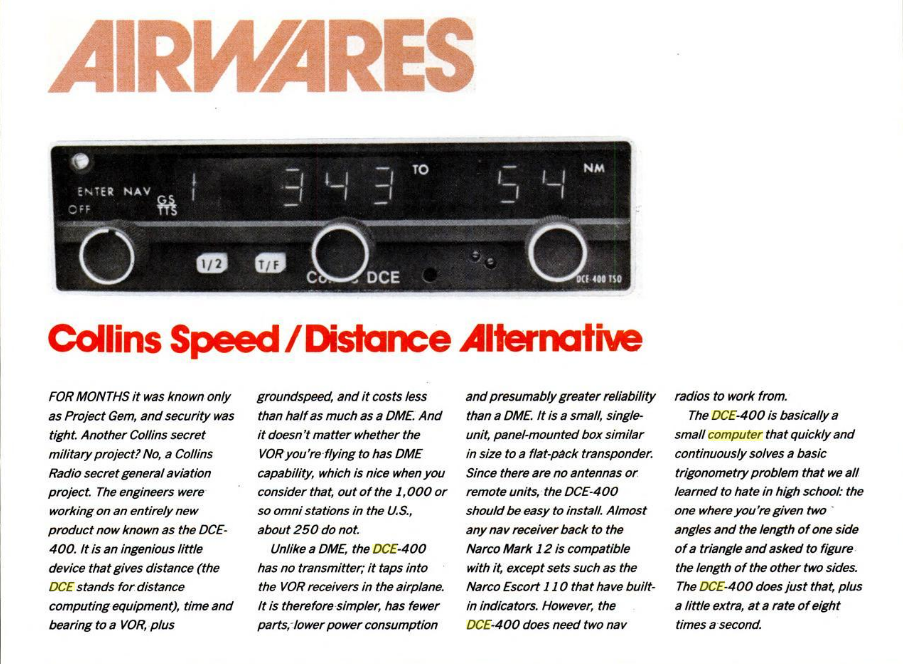I don’t see why you need all that. Two VORs give you an unambiguous position – would be nice to have 3 for confirmation but not essential. There used to be approaches that worked that way, with step-down fixes based on interception of specific radials from another VOR so you could do them without DME (though the proverbial one-armed paper-hanger would be useful).
So you know where you are, and you know where you want to go. All you have to do is point in the right direction. Winds will give you a problem, but they did in the good old days of VOR (or NDB) navigation too. You point in what you think is the right direction and look for drift. Then you do some improbably complicated mental trigonometry and figure out which way to point to get to where you want to be. But computers are good at that sort of thing.
Peter wrote:
how would it be done without DME i.e. radiation
I can actually imagine that with the high speed computation available today you can build a device that receives both the interrogations from (several) other aircraft and the replies and use the relative timing to determine your distance from the DME station. There are enough CAT with DME/DME RNAV that you can be virtually certain that there are enough aircraft interrogating the DME.
I tried yesterday on the ground to pull the GIA63 circuit breakers to see how reliable the magnetometer would be for dead reckoning mode without GPS in case of a GPS outage. Although I would need to try the same when flying in the air, I think it would be pretty reliable to be able to continue flying IFR to stay on radar vectors or to fly somewhere to fly a non GNSS-based instrument approach or to get to VMC.
The magnetometer doesn’t suffer from many of the analogue compass errors, and smaller GA aircraft wouldn’t normally need to travel very large distances to get to an airport to land in case of widespread GPS outage.
I don’t see how the above proposals would work – other than by a lot of guesswork and gradually solving for the unknowns, knowing TAS and heading. The heading and TAS will also contain errors but like I say, there is enough data…
Collins used to provide a DCE 400. It was a long time ago and I don’t recall it being particularly successful in the marketplace.

Peter wrote:
I don’t see how the above proposals would work – other than by a lot of guesswork and gradually solving for the unknowns, knowing TAS and heading. The heading and TAS will also contain errors but like I say, there is enough data…
There is a lot of data indeed. The book I learned the details of avionics from actually had a passage saying (more or less) “by now the reader may ask how a DME can work at all”, followed by a detailed statistical analysis showing that it actually can.
DME works despite not having special-ID packets because the return time is far shorter than somebody else’s packets being triggered. This is achieved by imposing an upper limit on the interrogation rate which, together with the speed of light, determines the DME interrogator saturation limit.
This job is completely different because you don’t have the transmit timestamp. Imagine a single interrogator around; you have no idea where that interrogator is, on a circle around that DME whose radius will be the response delay. Somebody very clever could work out whether this is possible or not, but remember that if we have a no-GPS scenario then the number of interrogators will dramatically shrink too.
DME saturation is around the 100 aircraft mark IIRC.
It also has limited range as does VOR
NDBs not much good at night or in coastal regions.
Locators have even less range, something like 25NM IIRC so in the event of a sudden GPS outage you could use dead reckoning and vectors to get you to an alternate with locator.
The locators that are being left in place are normally the ones associated with an ILS.
So in the case of a planned GNSS approach followed by an unexpected outage you would also have planned an alternate either in VFR conditions or one with an ILS.
This is roughly what the regulations used to call for. They may well have changed under the latest NCO regs.
Peter wrote:
DME works despite not having special-ID packets because the return time is far shorter than somebody else’s packets being triggered. This is achieved by imposing an upper limit on the interrogation rate which, together with the speed of light, determines the DME interrogator saturation limit.
That’s not the case. A DME station can typically accept 2700 interrogations/second. (Source.) If they are perfectly evenly spaced, the interval is 370 µs. Given the design turnaround delay of 50 µs, this corresponds to a distance of just 26 NM, so certainly the DME station will receive more requests during the turnaround time of the previous request.
Also, in tracking mode, the DME interrogator will only consider replies in a “window” around the turnaround time of its last known distance.
That’s fair enough but still no idea on how to actually do it, without emitting anything.